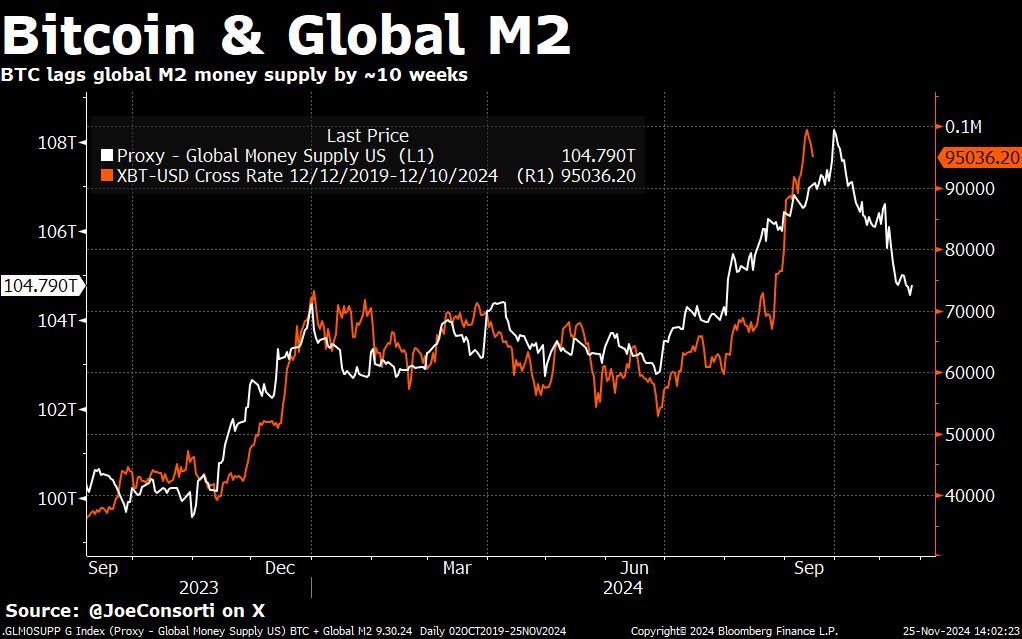-
Recent analysis indicates that Bitcoin (BTC) may be facing a considerable correction, closely linked to shifts in the global M2 money supply.
-
A combination of reduced liquidity and increased institutional interest raises questions about Bitcoin’s immediate price stability.
-
Notably, Joe Consorti highlighted, “Bitcoin could experience a 20-25% correction” if current M2 trends persist.
This article examines Bitcoin’s potential for a price correction due to changes in global M2 money supply and ongoing institutional interest.
Why Bitcoin May Be Due for a 25% Correction
Bitcoin custody firm Theya’s head of growth, Joe Consorti, has highlighted Bitcoin’s close tracking of the global M2 with an approximately 70-day lag since September 2023. In a recent post on X (formerly Twitter), Consorti warned of a potential BTC pullback by 25% as it continues to track the global M2.
“I don’t want to alarm anyone, but if this trend continues, Bitcoin could experience a 20-25% correction,” Consorti said.
His analysis sets M2 data 70 days forward compared to Bitcoin’s price, revealing a worrying trajectory as global liquidity tightens. Consorti’s observations come amid a rare dislocation from the M2 trend, which historically aligns with Bitcoin prices.

He attributes past divergences, such as during the 2022 FTX collapse, to market-specific events. In hindsight, on September 30, Consorti predicted Bitcoin could hit $90,000 by year-end if it continued mirroring M2 trends. That forecast played out accurately during BTC’s recent rally, bolstering his credibility.
Another proponent of this correlation, user Joseph Scioscia, reiterated that Bitcoin acts as a reliable proxy for M2 money supply trends. He advised investors to adopt a long-term dollar-cost-averaging (DCA) strategy, citing BTC’s historical resilience.
“Bitcoin is the best proxy for M2 money supply. The trend in M2 reveals the potential direction in BTC, especially with Bitcoin’s approximate 70-day lag behind M2. DCA in Bitcoin and adopt a long-term strategy,” Scioscia stated.
However, skepticism remains. An X user known as Spicez criticized the focus on short-term data. They argue that a broader five-year chart would offer more insight into Bitcoin’s behavior during election cycles and post-halving periods.
“It would be nice to see this chart for the last 5 years. It would give us an indication of BTC’s behavior towards M2 during the election cycle and how it behaved after the last halving. This 2-year chart doesn’t tell us much at all,” Spicez challenged.
Crucial Link Between M2 Money Supply and BTC
The global M2 supply measures the total liquidity in the economy, including checking accounts, savings accounts, and other liquid assets that can be quickly converted into cash. It has been a key driver for Bitcoin’s price movements.
Risk assets, including Bitcoin, typically correlate with rising liquidity. The relationship between Bitcoin’s price and M2 expansion reflects broader market sentiment and economic conditions.
A higher M2 expansion indicates a loose monetary policy and an increased money supply, which often boosts risk assets like cryptocurrencies. Historically, increases in M2 correspond with bullish trends for Bitcoin as liquidity flows into risk assets. Conversely, declines often signal impending corrections.
In a recent analysis, COINOTAG echoed this link, suggesting that global liquidity could help Bitcoin reach $100,000. As reported, factors like the 2024 Bitcoin halving and broader macroeconomic recoveries often act as tailwinds for BTC’s price.
The rising interest in Bitcoin ETFs (exchange-traded funds), particularly from institutions like BlackRock, could counteract M2-related pressures. Structural buying from ETFs, coupled with corporate acquisitions, may provide a cushion against liquidity-driven sell-offs.
“It [Bitcoin] could buck this 2-month bout of M2 deflation thanks to structural ETF inflows + corporate buying pressure,” Consorti added.
While Bitcoin’s price faces potential headwinds from shrinking global liquidity, the market remains divided on its next move. Structural inflows and long-term adoption strategies may temper any downside. However, traders should brace for volatility as macroeconomic factors play out this week.

At the time of writing, Bitcoin is trading at $94,395. COINOTAG data shows it has been down 3.37% since the Tuesday session opened.
Conclusion
As we analyze Bitcoin’s positioning within the evolving liquidity landscape, it’s evident that both macroeconomic indicators and institutional interest play critical roles. While potential corrections loom, the cryptocurrency’s historical resilience and the ongoing demand for ETF products may contribute to its stability moving forward. Investors are encouraged to remain vigilant and consider long-term strategies amid short-term fluctuations.
